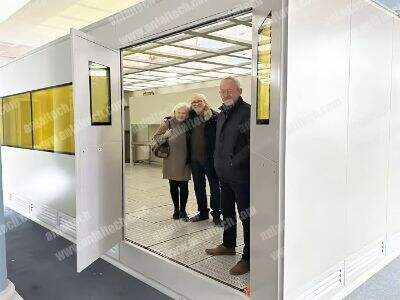For maintaining the cleanliness and the safety in manufacturing room
Anlaitech realizes that ISO 7 cleanroom validation is crucial. This includes thorough testing of air and surfaces to the required standards. So, we’re going to dig a little deeper into the ISO 7 clean room validation and its step-by-step guide, and what are some of the common problems that could occur during the steps?
A Step-by-Step Guide
First, some configuring of the equipment to allow air and surface testing in our ISO 7 Cleanroom. This will cover particle counters, microbial samplers and swabs for surface monitoring. Then, the air test is performed for determination of dust counts in the atmosphere. This step is to satisfy the cleanliness level of air. This is followed by surface testing, where selected points for swabbing at various places of the clean room are tested for microbial contamination. After all testing is completed, results will be reviewed to see if the class 100 cleanroom complies with ISO 7 validation metrics. If any concerns are found, necessary steps should be performed to resolve them prior to retesting.
Typical Problems with ISO 7 Cleanroom Validation
Then there are many common problems that come with validation. One of the main concerns is particle contamination in air, which can stem from bad ventilation or filtration systems. This may cause the number of particles to exceed ISO 7 standards, which means you would need to adjust the clean room environment. Also, surface contamination is another issue that occurs frequently because of poor cleaning or inappropriate disinfection. To overcome this problem, accurate cleaning procedures are required to ensure aseptic environment. In addition, equipment failure can also affect the validation effort; particle counters or microbial samplers that are malfunctioning will give erroneous results. Periodic maintenance and validation of the testing components are needed to avoid these problems and to maintain accurate results on qualification tests.
Top Questions to Inquire Before Selecting ISO 7 Cleanroom Validation Company
There are a number of things to consider when finding a company that can perform ISO 7 cleanroom validation. First, inquire into the provider's experience in air and surface testing of clean homes. You want to make sure you select a company who has mastered the niche. Also ask what type of validation techniques and equipment do they use and if they are industry standard.
Another question to ask is if the company can provide a full spectrum of validation services such as airborne particles, microbial contamination and any other likely source of contamination testing. This will ensure that your class 1k cleanroom needs the required quality and safety standards. Also, inquire about a turnaround time on the validation reports, clean operation room is key and you need this information fast.
Understanding the ISO 7Cleanroom Validation Process
Several key steps are necessary to properly validate an ISO 7 cleanroom Parker Domnick Hunter offers some guidance for those concerned with the cleanliness and effectiveness of the controlled environment. First and foremost, the company will need to perform air testing to measure airborne particle levels and make sure they fall within appropriate thresholds. This usually requires expensive tools, like particle counters and air samplers.
Then the cleanliness of surfaces in a clean room is evaluated by surface test. It includes the Collection of Swab of different places to see if there is any Microbial & cross contamination. The samples will be analyzed by the provider in laboratory conditions to guide any necessary corrective measures for sterility.
During the validation auto detailing, make sure that the provider keeps a comprehensive record of all test results and evaluations. This paper will identify the problem areas and offer corrective action to obtain an ISO 7 cleanroom.
Getting the Most Out of Your ISO 7 Cleanroom Certification
With ISO 7 cleanroom validation, business can use it to be more efficient and ensure quality remains elevated. A validated clean room, is a controlled environment which is designed to minimize contamination and maintain product quality. This is particularly important for pharma, electronics and biotech markets where fine particles can have a big impact on product quality.
Furthermore, ISO 7 room certification enables enterprises to meet regulatory requirements and industry standards. Regular cleanroom static pass box validation allows companies to prove their dedication to quality and safety, bolstering their image and reputation in the industry.
In the end, ISO 7 cleanroom validation is a vital step for companies who want to uphold a cleanliness-focused work environment. Simply answering the right questions, understanding the validation process and stressing efficiency and quality can help a company bring its cleanroom into the appropriate realm to support success.
Table of Contents
- For maintaining the cleanliness and the safety in manufacturing room
- A Step-by-Step Guide
- Typical Problems with ISO 7 Cleanroom Validation
- Top Questions to Inquire Before Selecting ISO 7 Cleanroom Validation Company
- Understanding the ISO 7Cleanroom Validation Process
- Getting the Most Out of Your ISO 7 Cleanroom Certification





